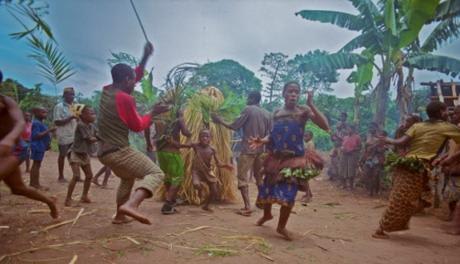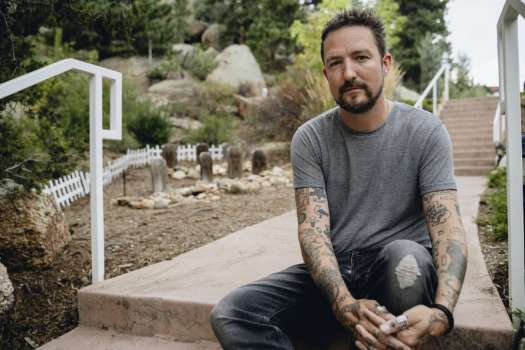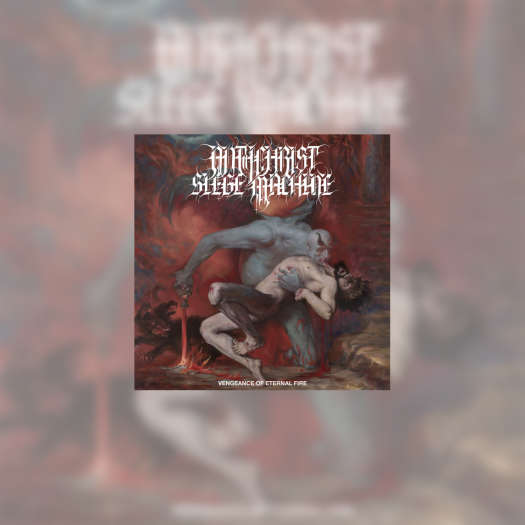In a pocket of virgin rainforest located within the Congo Basin, the Oka people carry on a way of life that has remained almost entirely free of Western influence. Swedish filmmaker Linda Vastrik was kindly permitted to live with the tribe for several years and has assembled Forest of the Dancing Spirits out of her footage of a dramatic period of time that might well become one of the last documents of an insular indigenous culture simply existing in accordance with their heritage.
Even though the film is being sold as a real life Ferngully situation – a large logging company wants to build a road right through the Oka hunting village – Vastrik doesn't resort to turning her film into an act of protest or political manoeuvring; she's just there to observe and share her findings. Her focus is on presenting the unique customs and values of a people who are connected to the cycle of life so intimately that it is jarring to outsiders accustomed to the clinical remove of our society.
The meaning of life is simple for the Oka: to reproduce. Removed from any other form of ambition, procreation is everything. As such, birth and death are the most significant events for the community.
To depict how all consuming the process is naturally, Vastrik keeps close tabs on an expectant mother who lost her previous baby during childbirth. Lacking the kind of information exchange that leads to technological and psychological progress, the Oka people believe in and practice black magic. Anything bad that happens is attributed to evil powers and must be investigated by the resident witch doctor.
These superstitions come from a surprising source: their "Owners". All pygmy people "belong" to a physically larger Congolese people whose ancestors subjugated the diminutive forest dwellers "like you white people took us".
It's not clear whether this skewed symbiosis predated or was inspired by the slave trade. Either way, it is what it is, and knowing nothing else, the Oka people accept it, thankful for the tools they receive in exchange for their obedience and fearful of incurring the wrath of their dominators.
At times, the rituals the Oka engage in are uncomfortable to watch – an infant funeral and cosmetic tooth chiselling as a right of passage, especially – but it's fascinating to see these ancient customs being practiced and Vastrik seems to be such an innocuous presence that the villagers allow her to capture their most intimate moments unguarded. Actually, the only time these hard, industrious people display any embarrassment is when being filmed while eating (some invasions of privacy are universal).
As emotionally taxing as it can be, Forest of the Dancing Spirits is worth watching for the rare look at the beginning of the end of a way of life for an entire culture it provides.
Sadly, unless someone like, say, James Cameron, decides to nut up and put his money where his mouth is to protect indigenous habitats (they aren't blue and they don't have hair sex, but these are Earth's Na'vi), it might also eventually end up being the only way the descendants of the Oka will have to remember their heritage.
(Eye Steel/Linda Vastrik Filmproduktion)Even though the film is being sold as a real life Ferngully situation – a large logging company wants to build a road right through the Oka hunting village – Vastrik doesn't resort to turning her film into an act of protest or political manoeuvring; she's just there to observe and share her findings. Her focus is on presenting the unique customs and values of a people who are connected to the cycle of life so intimately that it is jarring to outsiders accustomed to the clinical remove of our society.
The meaning of life is simple for the Oka: to reproduce. Removed from any other form of ambition, procreation is everything. As such, birth and death are the most significant events for the community.
To depict how all consuming the process is naturally, Vastrik keeps close tabs on an expectant mother who lost her previous baby during childbirth. Lacking the kind of information exchange that leads to technological and psychological progress, the Oka people believe in and practice black magic. Anything bad that happens is attributed to evil powers and must be investigated by the resident witch doctor.
These superstitions come from a surprising source: their "Owners". All pygmy people "belong" to a physically larger Congolese people whose ancestors subjugated the diminutive forest dwellers "like you white people took us".
It's not clear whether this skewed symbiosis predated or was inspired by the slave trade. Either way, it is what it is, and knowing nothing else, the Oka people accept it, thankful for the tools they receive in exchange for their obedience and fearful of incurring the wrath of their dominators.
At times, the rituals the Oka engage in are uncomfortable to watch – an infant funeral and cosmetic tooth chiselling as a right of passage, especially – but it's fascinating to see these ancient customs being practiced and Vastrik seems to be such an innocuous presence that the villagers allow her to capture their most intimate moments unguarded. Actually, the only time these hard, industrious people display any embarrassment is when being filmed while eating (some invasions of privacy are universal).
As emotionally taxing as it can be, Forest of the Dancing Spirits is worth watching for the rare look at the beginning of the end of a way of life for an entire culture it provides.
Sadly, unless someone like, say, James Cameron, decides to nut up and put his money where his mouth is to protect indigenous habitats (they aren't blue and they don't have hair sex, but these are Earth's Na'vi), it might also eventually end up being the only way the descendants of the Oka will have to remember their heritage.




